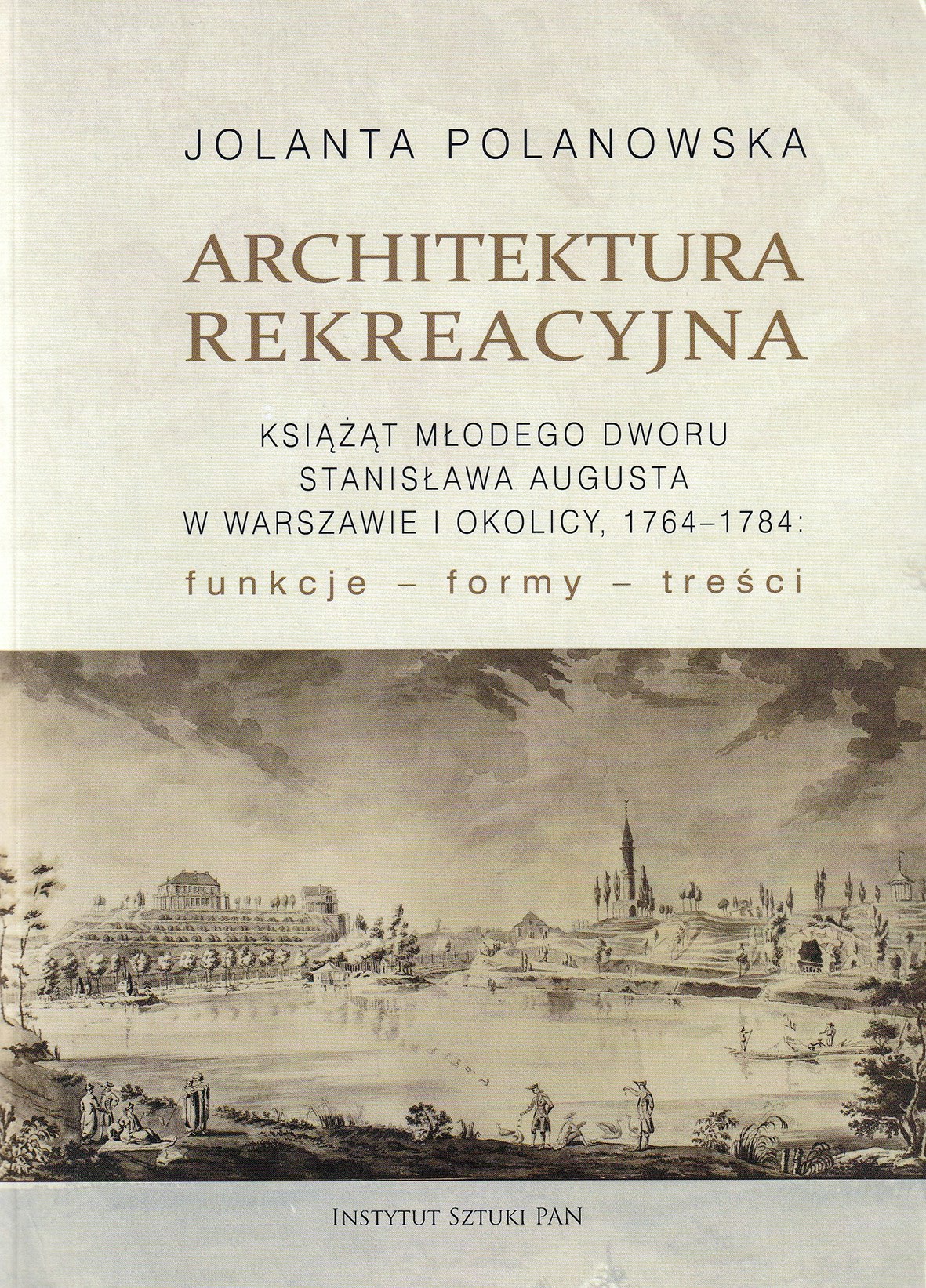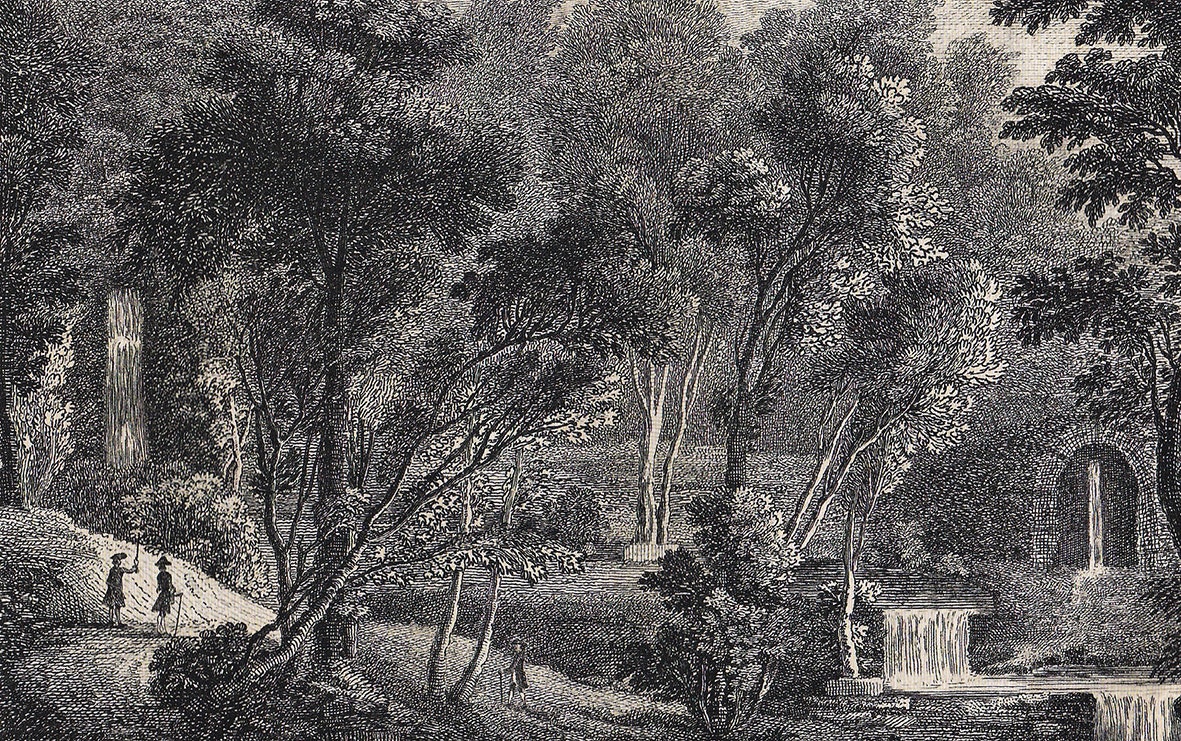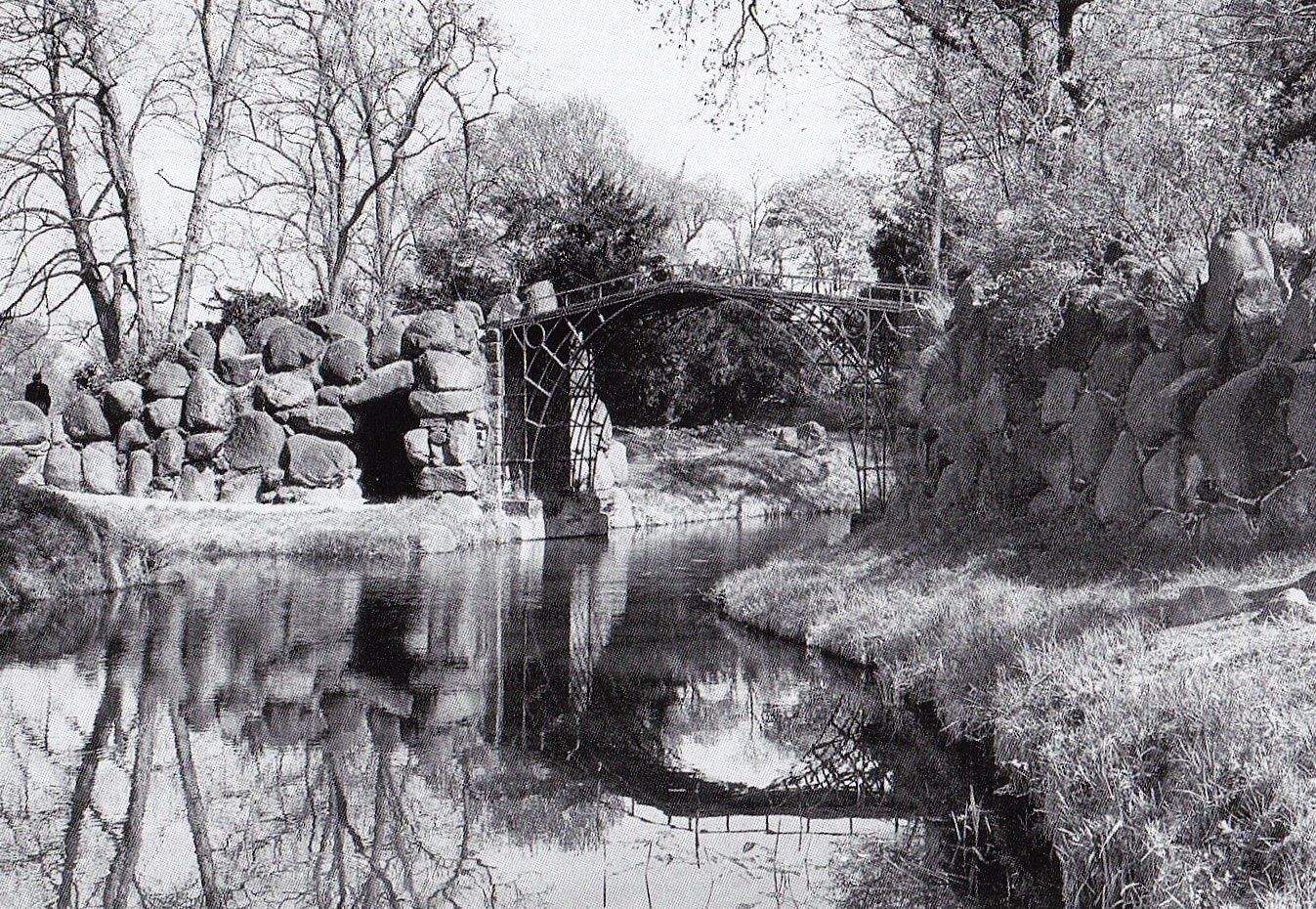Landscapes of allusion and illusion
On the architecture of recreation

Two books have recently landed on my desk which deal in differing ways with images of the Landscape Garden: one is Prints and the Landscape Garden: Image, Illusion, Illumination by the distinguished historian Michael Symes (London: John Hudson Publishing, 2024, ISBN: 978-1-7398229-6-5), and the other is Architektura Rekreacyjna by the equally distinguished Polish academic, Jolanta Polanowska (Warsaw: Instytut Sztuki Polskiej Akademii Nauk, 2024, ISBN: 978-83-66519-76-3).

The former is a study of the prints commissioned by owners of 18th- and early 19th-century landscape gardens to represent (or misrepresent) their properties, so such images often take liberties with their subjects, thus can sometimes be regarded as propaganda. It is odd that, given the importance of prints to influence taste, not to mention the immense part they played in the history of the landscape garden, this book is the first devoted to the topic. This makes it a major contribution to an understanding of how knowledge of the English landscape garden was disseminated internationally via widely available prints. The latter deals with the extraordinary recreational architecture of the princes and magnates of the young Court of Stanisław II Augustus Poniatowski, the last King of Poland (r.1764-95), in Warsaw and its vicinity, 1764-84, a period in which that country entered what could have been a remarkably enlightened phase of its history, and acquired exquisite landscape gardens influenced by English, Saxon, and French developments, but going even further into the realms of meaning, fancy, and allusion, much strongly influenced by Freemasonry. Such a lurch towards reform, independence, education, and freedom of thought caused alarm-bells to ring in Russia, Prussia, and Austria, with the terrible consequences that led to the disappearance of Poland from the map until 1918.
Symes points out that prints “chart the progress and development of garden design, but, perhaps more importantly, they also indicate how gardens were perceived at the time and how owners or artists wanted them to look … While the designed landscape grew in richness and complexity, the techniques of printmaking developed to rise to a higher standard of reproducing garden scenes. This resulted, particularly in the mid-18th century, in many images that are exceedingly attractive in their own right as pictures. Garden prints can, at their best, be highly atmospheric and give real aesthetic pleasure. And even where the visual quality is not so pronounced a print can still have much to tell.”
Prints ensured wide circulation of an image and were readily available, so were an important element in mass-communication, thereby disseminating ideas and taste. Symes correctly points out that whether a print merely reflected fashion or helped to create it is a moot point: prints might illustrate a narrative of the evolution of the landscape garden, but they could also act as drivers of that historical story. It is interesting that prints of the same garden at different periods are useful records of changes in style and taste: Symes tells us that the aims of his book are to show the range of depiction of gardens in the mid- to late 18th century, to “read” gardens from prints, and to attempt to determine what they reveal or tell us about attitudes to the landscape garden. “The element of illusion looms large in the landscape garden, things appearing to be what they are not” (“ruins”, for example, recently erected as an eye-catcher, might not be just there for æsthetic reasons, but to give an aura of antiquity to the “landskip”, and thereby a suggestion that the current owner’s family had been in possession of the estate for centuries [which was often not the case]): how better, Symes asks, “to convey the deception than by presenting it in pictorial form, giving apparent substance to the illusion?”


Certainly it would be impossible to study the 18th-century English landscape garden without “recourse to the wealth of evidence provided in the form of prints”. I have often marvelled at the skills of so many competent engravers working in these islands at the time, and Symes reproduces numerous excellent examples. What is more, although we still have fine examples of the English landscape garden embellished with architectural elements all saturated in meanings and allusions (like Stowe, in Buckinghamshire, some gardens have proved to be more ephemeral, including that at The Leasowes, seat of William Shenstone (1714-64), near Halesowen, West Midlands, then part of Shropshire, with its Virgilian groves, Gothick “ruins”, urns, and other elements, all with inscriptions to inform the visitors). And of all gardens, the most ephemeral of all were the once extremely popular pleasure-gardens of London, some associated with allegedly medicinal waters, so acquired the alluring label of “Spaw” to attract custom. Symes illustrates a few of these, including the huge and once-celebrated Vauxhall Gardens, but they were many and varied, as I well know, having delved into the topic myself in some detail (see my Spas, Wells, & Pleasure-Gardens of London [2010], now out of print, although I still have a few copies for sale).

All in all, Symes’s book is well produced, and the prints are for the most part attractively and clearly reproduced, although it is 285 cms wide x 225 cms high, a shape unaccountably favoured among garden historians (the Journal of Garden History is 270 cms wide x 210 cms high), so one has to have very deep shelves to house such a volume with comfort. He mentions a few Continental gardens en passant, including those at Ermenonville, Schwetzingen, Wilhelmshöhe, and Weimar, but his illustration of the “Grecian Arch” and “Temple of Diana” at Arkadia in Poland, an aquatint by John William Edy (1760-1820), after “R. Norbelin” (presumably Jean-Pierre Norblin de la Gourdaine, aka Jan Piotr Norblin [1773-1830]), produced in London in 1786 is not accurate, as Symes himself acknowledges. Indeed, the coverage of Continental gardens, many of which are actually far more interesting than the English gardens which were the catalysts for Continental developments, is cursory in the extreme, which is a pity.
This is where Polanowska’s book comes into its own, although the reproduction of the prints and other illustrations in her book leaves much to be desired, as they are very small, and often rather murky. In my travels in Germany and Poland I was struck by the importance of literary allusions to gardens, especially in that heartrendingly tender novella by Johann Wolfgang von Goethe (1749-1832), Die Wahlverwandtschaften (Elective Affinities) of 1809, where there are clear references to the wonderful Gartenreich, an “England-by-the-Elbe”, created for Leopold III Friedrich Franz (1740-1817), reigning Prince of Anhalt-Dessau from 1751 by his architect, Friedrich Wilhelm, Freiherr von Erdmannsdorff (1736-1800), and his gardeners, Johann Leopold Ludwig Schoch (1728-93), Johann Georg Schoch (1758-1826), and Johann Friedrich Eyserbeck (1734-1818). From the start, this Garden Kingdom, extending over 300 square kilometres, and including Wörlitz, was intended to have an educational programme, all the designs following the advice of Horace to combine the “useful with the beautiful”, and the place was enormously influential, not least in Poland, where certain German architects, such as Simon Gottlieb (transmogrified as Szymon Bogumił) Zug (1733-1807) designed several enchanting gardens for the Polish landed gentry and aristocracy, some with amazingly inventive fabriques associated with Freemasonry.

Goethe’s Elective Affinities contains a passage relating to the building of one of the garden structures mentioned in the novella, which is obviously Masonic, with its references to “the Mason’s business, … earnest secret labour, … lime and cement, … men cemented by the Law”, … and “the threefold blow blessing the union of the stone and the earth”. At Wörlitz the various buildings include a Rousseau-Insel (1782) based on the original at Ermenonville, France; a beautiful Ionic Nymphæum by Erdmannsdorff (1767-8), once a favourite spot of the poet Friedrich von Matthisson (1761-1831), whose lovely Adelaide, with its very first lines referring to the Frühlingsgarten, mild vom lieblichen Zauberlicht umflossen, was set by Ludwig van Beethoven (1770-1827) in 1795 and published in 1797. From this charming distyle in-antis portico, dedicated to the water-nymphs (Naiads), the visitor could rest and enjoy the view across the lake to the Englischer Sitz in the Schlossgarten. Matthisson, incidentally, died at Wörlitz: perhaps the unforgettable lines, Einst, o Wunder! Entblüht auf meinem Grabe eine Blume der Asche meines Herzens, were suggested by the enchanting vistas created in the wondrous Gartenreich, now very properly a World Heritage Site, which also contains a scaled-down version (1791) of the Iron Bridge in Shropshire, erected 1777-9 to designs by Thomas Farnolls Pritchard (1723-77); a rockwork Labyrinth, at the entrance to which the visitor is exhorted to choose his Path with Reason; a Stone Island on which was erected a “Villa Hamilton” and a rockwork “Vesuvius” (stuffed with fireworks on occasion to simulate an eruption); a circular Synagogue (to demonstrate open-mindedness and an absence of religious bigotry); a Gothic House (1773-1813), designed by Erdmannsdorff and Georg Christoph Hesekiel (1732-1818); and various waterways and Classical temples.


Now one of the curious aspects of scholarship concerning garden history, what Christopher McIntosh has aptly called “the symbol-strewn landscape”, is that the esoteric aspects of so many European gardens seem to scare English historians out of their wits, sending them whinnying in fright away from any whiff that might suggest Freemasonry, the Arcane, or even aspects of Religion. This is all the more peculiar because many major figures in the architectural and intellectual worlds of the past were not only fascinated by such matters, but wrote about them: they included John Wood the Elder (1704-54), of Bath fame, Sir Christopher Wren (1632-1723), and even that almost deified figure of the Enlightenment, Sir Isaac Newton (1642-1727). The last’s detailed study of the measurements of the Temple of Solomon was published in Chronology of Ancient Kingdoms Amended (1728): in that work he attempted to determine the dates of events in Antiquity from astronomical considerations, and mixed up mythological and historical happenings. One cannot visit certain gardens or palaces in Central Europe without (providing one has one’s wits in a state of alert) noticing that allusions to Freemasonry are present in many places. There are fine pieces of Meissen porcelain, for example, which overtly depict Masonic aprons, pug-dogs (called Mops in German, connected with Lodges of Adoption), and figures with fingers to lips, an allusion to keep silent. Such extraordinary queasiness in relation to The Craft is weird: I would suggest that any organisation that incurred the hostility of the National Socialist German Workers’ Party, Soviet Communism, Vichy France, the Papacy (the Craft was attacked in 1738 in an Act of Condemnation commencing In eminenti under Clement XII [r.1730-40]), the Spanish Falangists, sundry Ayatollahs, and many loopy members of the British Left, must have something in its favour.
The Poles have not been so leery about Freemasonry, and indeed their investigations into that brief yet fascinating period into their nation’s tragic history have acknowledged the influence of aspects of the Craft on the design of several gardens during the short yet remarkable time when the young King, who worshipped Reason yet was led by his Heart, who professed Catholicism yet believed in Providence, who flirted with esoteric ideas and with the ideals of Freemasonry which had flowed eastwards through Europe in the course of the 18th century despite denunciations from Rome, who spent fortunes on education, art, and cultural projects, who was stymied politically (largely by Russia), and who put all his energies into a national social and artistic regeneration that was extraordinarily symbolised in the design of gardens. It should be remembered that Saxon influences in Poland were considerable, for the Prince-Elector (Kurfürst) of Saxony, Friedrich August I (“The Strong”), became Augustus II, King of Poland in 1697, and although deposed in 1704, was restored in 1709, and reigned until his death in 1733, being succeeded by his son, who reigned until 1763 as Augustus III of Poland and as Friedrich August II, Kurfürst of Saxony. Although neither Elector did much for Poland, some gifted architects and artists from Saxony settled in Poland, adapted their names to Polish forms, and made a considerable contribution to Polish architecture and garden design, none more so than Szymon Bogumił Zug, who lived in Poland from 1756. There were others, too, who did much to add lustre to architectural design during Poniatowski’s reign, including Ephraim Schröger (1727-83), who is sometimes referred to as Efraim Szreger: his contributions are mentioned in Polanowska’s fascinating tome. What is of particular interest is Polanowska’s treatment of the complicated sequence of houses, gardens, and fabriques at Powązki, Mokotόw, Solec, Gόra, and Książęce created for members of Poniatowski’s “Young Court” during those few years of idealistic Polish Renewal when the English landscape garden was transformed into something very rich but strange, stuffed with symbolism, and fecund with new ideas.
All gardens require perambulation in order that their complexities and delights can be fully enjoyed, so are suggestive of longer journeys, even a lifetime of searching, and it was often the purpose of gardens to trigger memories in educated minds, to suggest new thoughts by means of allusion, and to stimulate, enlighten, evolve, and propose. At Schwetzingen, once the summer palace of Karl Theodor, Elector Palatine from 1742, the gardens are among the most pleasing delights of a rich geographical area, but the climax is the journey via the Bath House out of which the visitor, washed and enlightened, could proceed through two in-antis columns along a magical route defined by paths and trellis-work, the vista emphasised by theatrical perspective. He or she would then come to a sunlit elliptical space in the centre of which is a pool and an eagle-owl attacking a frightened bird, but all around are birds as fountains, in attitudes of protest, showing compassion for the victim of the eagle-owl. The berceau en treillage then leads down to a distant view, a dramatic and theatrical element called The End of the World: it is painted on a wall and illuminated from above.
So the visitor, cleansed, passes through transformed nature to a vision of unspoiled natural loveliness, where all appears “inexpressibly rare and delightful”, and all things are “spotless, pure, and glorious”. The climax of this great garden is in fact a Garden, a paradise, a lost Eden.

Enjoying The Critic online? It's even better in print
Try five issues of Britain’s most civilised magazine for £10
Subscribe














